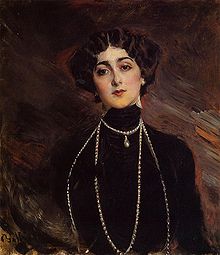Lina Cavalieri
Lina Cavalieri | |
|---|---|
Firenze , Kingdom of Italy | |
| Occupations |
|
| Spouse(s) | Alexandre Bariatinsky (m. 1899–1900) Robert Winthrop Chanler (m. 1910–1912; divorced) Lucien Muratore (m. 1913–1927) Paolo d'Arvanni (m. 19??—1944; their deaths) |
| Children | Alexandre Bariatinsky, Jr. |
Natalina "Lina" Cavalieri (25 December 1874 – 7 February 1944)[1] was an Italian operatic dramatic soprano, actress, and monologist.[2]
Biography
Lina Cavalieri was born on
At a young age, she made her way to

Cavalieri remained with the Metropolitan Opera for the next two seasons, performing again with Caruso in 1907, in Puccini's Manon Lescaut. She became one of the most photographed stars of her time. Frequently referred to as the "world's most beautiful woman", she was part of the tightlacing tradition that saw women use corsetry to create an "hour-glass" figure.[citation needed]
During the 1909–10 season she sang with Oscar Hammerstein's Manhattan Opera Company. Her first marriage long over, she had a whirlwind romance with Robert Winthrop Chanler (1872–1930), a member of the Astor family and Dudley–Winthrop family. They married on 18 June 1910 but separated by the end of their honeymoon, and their divorce became final in June 1912.[7]
After the divorce, Cavalieri returned to Europe where she became a much-loved star in pre-revolutionary

During her career, Cavalieri sang with other prominent singers, including
When that country became involved in
After marrying her fourth husband, Paolo d'Arvanni, she returned to live with her husband in Italy. Well into her sixties when World War II began, she nevertheless worked as a volunteer nurse.
Cavalieri was killed on 7 February 1944 during an Allied bombing raid that destroyed her home in Florence near Poggio Imperiale, where she had been placed under police surveillance because of her foreign husband. Hearing an American bomber nearby, Cavalieri, her husband, and the servants ran to the air-raid shelter in the grounds, but Cavalieri and her husband were delayed because they were collecting her valuable jewellery from the house.[8] Both Cavalieri and her husband were killed running to the air-raid shelter, while the servants inside the shelter all survived.[8]
Legacy
Lina Cavalieri's discography is rather slim. In 1910, for Columbia, she recorded arias from La bohème, Tosca, Manon Lescaut, Carmen, Mefistofele, and Faust, as well as "Maria, Marì! (Ah! Marì! Ah! Marì!)." In 1913, also for Columbia, she recorded Italian songs. In 1918, for Pathé, the soprano recorded two songs, the aria from Hérodiade, and three duets with Muratore.
Her portrait was painted by the Italian artist Giovanni Boldini (acquired by Maurice de Rothschild) and by the Swiss-born American artist Adolfo Müller-Ury. The latter painting is now the property of the Metropolitan Opera, the gift of Nicholas Meredith Turner in memory of his wife, the soprano Jessica Dragonette. Hers is the inspiring beauty that appears in several works by Piero Fornasetti.
In 1955,
Family
From her relationship to Alexandre Bariatinsky, Lina had one son, Alexandre Bariatinsky, Jr.[7] He was serving in the Italian Army early in WW1 when she went to the authorities trying to find him.[9]
Films


- Manon Lescaut (1914)
- Sposa nella morte (1915)
- The Shadow of Her Past (1915)
- The Rose of Granada (1916)
- The Eternal Temptress (1917)
- Love's Conquest (1918)
- A Woman of Impulse (1918)
- The Two Brides (1919)
- The Crushed Idol (1920)
- Mad Love (1920)
Iconography
- Antonio de La Gandara– Portrait of Lina Cavalieri
- Piero Fornasetti – 'Tema e Variazioni' series
Bibliography
- Bianchi, Piero (1969). Francesca Bertini e le dive del cinema muto. Turin: UTET.
- Martin-Hattemberg, Jean-Marie (2014). Isabey Paris, Parfumeur depuis 1924. Paris: Gourcuff Gradenigo.
- Lina Cavalieri, Le mie verità, redatte da Paolo D'Arvanni, Roma, Soc. An. Poligr. Italiana, 1936;
- Vincenzo De Angelis, Lina Cavalieri e Gabriele D'Annunzio, Roma, Fratelli Palombi, 1955;
- Vittorio Martinelli, L'avventura cinematografica di Lina Cavalieri, S.l., s.n., 1986;
- Franco Di Tizio, Lina Cavalieri, la donna più bella del mondo. La vita 1875-1944, prefazione di Dacia Maraini, Chieti, Ianieri, 2004.
- Lucia Fusco, Storie di donne che hanno fatto la storia: Lina Cavalieri, Nuova Informazione, Lt, A. XXIII, n. 12, pp. 302–303, Dicembre 2017.
- Franco Di Tizio, Lina Cavalieri "Massima testimonianza di Venere in Terra", Pescara, Ianieri, 2019.
- Fryer, Paul, and Olga Usova. Lina Cavalieri: The Life of Opera's Greatest Beauty, 1874-1944. McFarland, 2003.
References
- ^ New York Times – 9 February 1944
- ^ Lina Cavalieri: the Life of Opera's Greatest Beauty, 1874–1944 By Paul Fryer, Olga Usova 2004 pg. 4
- ^ Lina Cavalieri: the Life of Opera's Greatest Beauty, 1874–1944 (2006) By Paul Fryer, Olga Usova pg. 6
- ^ М. С. Барятинская. Моя русская жизнь. Воспоминания великосветской дамы. 1870–1918. — М. : ЗАО Центрполиграф, 2006. — 367 с.
- ^ ru:Барятинский, АлександрВладимирович (1870
- ^ Met Opera Archive: Performance of Fedora, 5 December 1906, CID:38090.
- ^ a b "Lina Cavalieri (1874–1944)". stagebeauty.net. 26 October 2013.
- ^ a b Bianchi 1969, p. 169.
- ^ The Opera Singer and the Silent Film by Paul Fryer 2005
External links
- La Gandara
- Lina Cavalieri at IMDb
- Lina Cavalieri in "Maria, Marì (Ah! Marì Ah! Marì)" on YouTube(audio only, 1910).
- "L'Altra Notte" -Lina Cavalieri(1910) on YouTube
- Lina Cavalieri: Broadway Photographs(Univ. of South Carolina)
